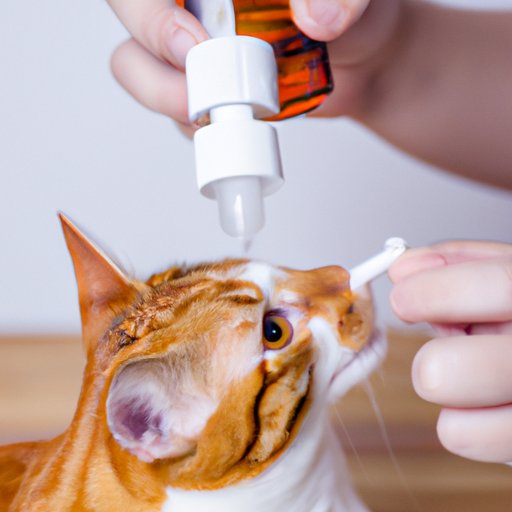I. Introduction
Giving your cat liquid medicine can be a frustrating and challenging task for many pet owners. It’s not uncommon for cats to resist taking medication, even more so when it’s in liquid form. But, medication is essential in helping your feline friend recover from illnesses or injuries.
This article aims to provide cat owners with a step-by-step guide and useful tips to make it easier for you to give your cat liquid medicine.
II. Step-by-Step Guide
A. Step 1: Preparing the Cat and Medication
Before you start administering the medication, it’s important to prepare your cat and the medication. Make sure that you have the right medication prescribed by your veterinarian. Check the label to ensure that it’s not expired and that you have the right dosage.
Once you have the medication, make sure to shake the bottle well to ensure the contents are well mixed and at room temperature.
B. Step 2: Restraining the Cat
Restraining your cat is crucial to ensure that the medication goes into their mouth and not elsewhere. Different methods are used to restrain cats, depending on their size, breed, and temperament.
One effective way to restrain a cat is to use a towel. You can wrap your cat in a towel, leaving only their head exposed. Ensure that the towel is wrapped tightly enough to prevent the cat from escaping, but not too tightly to make them uncomfortable.
C. Step 3: Administering the Medication
Once the cat is securely restrained, tilt their head back and gently insert the syringe into the corner of their mouth, between the cheek and teeth. Slowly and steadily, push the plunger to release the medication.
Make sure to hold the cat’s head slightly upwards during this process to prevent the medication from going down their windpipe and causing choking. Be sure to follow the prescribed dosage and avoid overdosing your cat.
D. Step 4: Rewarding the Cat
After administering the medication, it’s essential to reward your cat for their good behavior. Treats, petting, and praise are excellent ways to positively reinforce the experience and make it easier for your cat in the future.
III. Video Tutorial
A. Introduction to the Video Tutorial
Visual aids are important in helping pet owners understand medication administration better. Check out this tutorial to learn how to give your cat liquid medication step-by-step.
B. Demonstration of the Process of Giving a Cat Liquid Medicine
The video tutorial demonstrates the process of giving a cat liquid medication, emphasizing the key steps, restraining the cat, and administering the medication.
C. Discussing the Advantages of Visual Aids
Visual aids provide pet owners with practical demonstrations that allow them to understand and follow medication administration better. The video tutorial provides pet owners with a reliable resource that they can watch at any time in case they need a refresher.
IV. Common Mistakes
A. Over-medicating
One common mistake that pet owners make is giving their cats too much medication. Overdosing can lead to health complications, such as toxicity and organ damage. Always follow the prescribed dosage and seek veterinary care if you’re unsure.
B. Under-medicating
Under-dosing can be just as dangerous as over-dosing, particularly when antibiotics are involved. Under-dosing can lead to bacteria building up resistance, making it more challenging to treat infections in the future.
C. Incorrect Administration
Another common mistake is administering the medication incorrectly. The medication must go into the cat’s mouth and not down their windpipe. Administering the medication incorrectly can cause choking and lead to the medication not being effective.
D. Providing Solutions to Avoid These Mistakes
To avoid these common mistakes, always follow the dosage and administration guidelines provided by the veterinarian. If you’re unsure, seek veterinary advice to avoid health complications.
V. Focus on the Medicine
A. Different Types of Liquid Medicine That Are Commonly Prescribed for Cats
There is a wide range of liquid medications that may be prescribed for your cat, including antibiotics, anti-inflammatory medication, and pain relievers.
B. The Uses of These Medicines
Cats receive liquid medication for various reasons, such as treating infections, reducing inflammation, and managing chronic diseases.
C. Possible Side Effects
Every medication has its side effects, and liquid medication is no exception. Some cats may experience vomiting, diarrhea, or decreased appetite after taking the medication.
D. The Best Time for Giving Them
The best time to give cats liquid medications is when they are calm and relaxed, so it’s best to pick a time when your cat is most relaxed.
VI. Alternative Methods
A. Discussing Alternative Methods to Giving Liquid Medicine
If your cat refuses to take liquid medication, there are alternative methods you can explore.
B. Using Pill or Treat Pockets
Pill pockets are a popular option for administering medication. They are designed to hide the medication inside a treat, making it easier for cats to ingest.
C. Mixing the Medicine with the Cat’s Food
Another option is to mix the medication with your cat’s food, making it easier for them to ingest it. However, before doing this, consult with your veterinarian to ensure that the medication can be mixed with food.
VII. Conclusion
of What Has Been Covered
This article provides a step-by-step guide to giving liquid medication to cats and provides useful tips on how to avoid common mistakes, the best time to administer medication, and alternative methods.
B. Reinforcing the Importance of Giving Cats Liquid Medication
Administering medication to your cat is crucial, and liquid medications are no exception. Giving your cat medication ensures that they receive the proper treatment and recuperate faster from any illness or injury.
C. Encouragement for Cat Owners to Try the Step-by-Step Guide and Alternative Methods
Consistency is key, and with practice, giving cats liquid medications will become easier for both you and your cat. Don’t hesitate to use alternative methods as needed and always consult with your veterinarian if you have any concerns.
